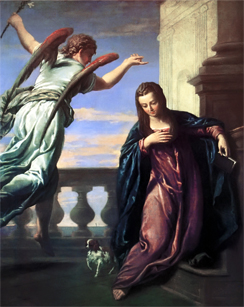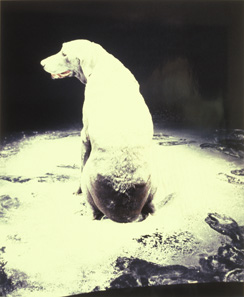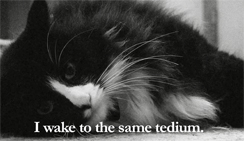Art that goes to the dogs (and cats)
"A story with legs" is what journalists sometimes call one that people can really relate to. That certainly applies to the subjects in the story Anna Werner is about to tell, partly because we share so much with them (and besides, they have twice as MANY legs as WE do):
They've been coming in packs, breaking attendance records at the Blanton Museum of Art in Austin, Texas, to see an exhibit called "In the Company of Cats and Dogs."
You might ask, for a serious institution like the Blanton, is a show about Fluffy, well, too fluffy?
"You could put together an exhibition where it was a fluffy exhibition, you really could, but we didn't do that here," said museum director Simone Wicha.
"We do have something that at every level, you could come in and just smile, because you've found your dog in the picture, or you could come in and learn something deep about history or psychology."
Of course when it comes to art, different people have their own preferences -- there are dog people and cat people. Luckily, art can break down barriers.
One visitor said, "We're cat people, but we can appreciate a well-rendered dog as well."
Turns out, our modern obsession with our pets isn't so modern at all. Artists have had four-legged muses for thousands of years.
Take the Ancient Egyptians: they revered cats for their fertility, and so the goddess Bastet was a woman with a cat's head -- carved in a sculpture over 3,000 years old.
"So if you were a young Egyptian woman, you may have had this very amulet nearby to bring you good fortune and having many children and being a great mother," said curator Francesca Consagra.
Not only that, Consagra said, "They had huge cat cemeteries near the temple to the goddess Bastet. And sometimes they would mummify mice and leave little bowls of milk for their their journey into the afterlife."
Fast-forward a few thousand years, and artists were still using pets to illustrate heavenly matters -- like Veronese, when he paired the Virgin Mary with a then-very fashionable dog in his painting, "The Annunciation."
"She's there with her book, her Bible, and her faithful companion, which was, most likely, a drop-eared Papillon, which aristocratic women would have as part of their retinue, as part of their daily life," said Consagra.
"So it was a sign of her high royal status. It was a sign of her faith -- and a sign of her wealth as well."
"It's not just to make the composition look nicer or to add a little ambiance or to create a setting, like a prop," said Consagra. "They actually have deep connections to status, class, personality, aspirations, and big philosophies.
Some pets illustrated heavenly matters; others, more earthly desires. Consider the poster created for an interior design company by Henri de Toulouse-Lautrec.
"What you see is a beautiful blonde in a negligee in bed," said Consagra, "and he's coming in. And he's giving this look to the maid, which is sort of like, 'It's time for you to leave now, you don't need to be here.' And then, you've got this very eager dog at the woman's lap, which is to imply a sort of sexual innuendo here, that this man is coming into do more than just redecorate."
"So the dog is kind of helping you know that there's something playful about to happen here?" asked Werner.
"Correct, and in bed!"
But sometimes the picture wasn't so rosy, especially for cats. For instance, when a medieval or Renaissance artist included a cat, it signified something sinister.
"The cat soon took on what's known as a familiar with sorcerers and witches," said Consagra. "The night, darkness, being stealthful -- these attributes of the cat made people think that it it was somehow associated with evil."
Not that every pooch or pussycat here is symbolic. Some are loving portraits from the hands that fed them, like Andrew Wyeth's Golden Retriever, Rattler," or Edward Hopper's neighbor's cat, named Perkins Youngboy.
One well-known artist who has the art world on a leash is William Wegman. For more than 40 years, Wegman's Weimaraners have been delighting and baffling audiences in photographs, books and videos.
"You know, there's something about dogs that makes you want to wonder what they're thinking about," Wegman told Werner. "And they let you do that. They let you look at them."
His contribution to the exhibit is a moving photograph of his first muse, Man Ray.
"That was the end of Man Ray's life," said Wegman. "I knew that he was sick. He was older. Turned out he had pancreatic cancer. I didn't know that. But you know, when he did pass, I wasn't prepared for it at all. It was just decimating. And I didn't get another dog for five years."
Eventually he did get another dog; he named her Fay Ray.
Since then, he's featured nine Weimaraners in his works.
"Every dog that I've had has lent a kind of different look and a different thing that they can do," he said. "There's crazy, there's narcoleptic, there's happy and eager. There's beautiful. There's different ways that I've pushed that."
And while Wegman has been creating dog videos for decades, the last few works in the exhibit are devoted to the decidedly modern phenomenon of the Internet cat video.
"I think they're mesmerizing, absolutely mesmerizing," said Consagra.
But are these feline features art?
"I think that says less about art and more about cats," she replied.
"It's in your art museum!" laughed Werner.
"Well, then all I can say is that it's another form of human expression," Consagra said.
Human expression -- that might give you paws.
For more info:
- "In the Company of Cats and Dogs," at the Blanton Museum of Art at the University of Texas at Austin (through Sept. 21, 2014)
- Follow the Blanton Museum on Twitter (@blantonmuseum), Facebook, Instagram, Tumblr and YouTube
- williamwegman.com




